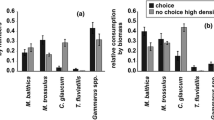Summary
The sea urchin, Centrostephanus coronatus, exhibits a relatively broad diet. Evidence presented in this paper suggests that evolution of dietary breadth is favored by two mechanisms. First, individual urchins occur in habitat types that support somewhat different foods. Urchins consume principally the most preferred food where it is common but are forced to eat other food types where it is rare. Second, overgrazing by individual urchins reduces the local abundance of the most preferred food, thereby forcing them to add less preferred items to their diet. Previous work indicates that the escape behavior of Centrostephanus from its fish predator, Pimelometopon pulchrum, results in different individuals being exposed to different foods and in reduction of the size of urchin grazing ranges to the point that overgrazing occurs. Hence, by the two mechanisms discussed in this paper, the presence of the fish predator favors the broad diet of its sea urchin prey.
Similar content being viewed by others
References
Breen, P.A., Mann, K.K.: Changing lobster abundances and the destruction of kelp beds by sea urchins. Mar. Biol. 34, 137–141 (1976)
Dayton, P.K.: Experimental evaluation of ecological dominance in a rocky intertidal algal community. Ecol. Monogr. 45, 137–159 (1975)
Dix, T.G.: Biology of Evechinus chloroticus (Echinoidea: Echinometridae) from different localities: I. General. New Zealand J. Mar. Freshwater Res. 4, 91–116 (1970)
Elmhirst, R.: Habits of Echinus esculentus. Nature, Lond. 110, 667 (1972)
Estes, J.A., Palmisano, J.F.: Sea otters: their role in structuring nearshore communities. Science 185, 1058–1060 (1974)
Estes, J.A., Smith, N.S., Palmisano, J.F.: Sea otter predation and community organization in the western Aleutian Islands, Alaska. Ecology 59, 822–833 (1978)
Fuji, A.: Ecological studies on the growth and food consumption of Japanese common littoral sea urchin Strongylocentrotus intermedius (A. Agassiz). Mem. Fac. Fish., Hokkaido University. 15, 83–160 (1967)
Glynn, P.W., Wellington, G.M., Birkeland, C.: Coral reef growth in the Galapagos: limitation by sea urchins. Science 203, 43–49 (1979)
Herring, P.J.: Observations on the distribution and feeding habits of some littoral echinoids from Zanzibar. J. Nat. Hist. 6, 169–175 (1972)
Ivlev, V.S.: Experimental ecology of the feeding of fishes, 302 pp. New Haven, Conn.: Yale University Press, 1961
Jones, N.S., Kain, J.M.: Subtidal algal colonization following removal of Echinus. Helgoländer wiss. Meeresunters. 15, 460–466 (1967)
Lawrence, J.M.: On the relationships between marine plants and sea urchins. Oceanogr. Mar. Biol. Ann. Rev. 13, 213–286 (1975)
Levins, R.: Evolution in changing environments: some theoretical explorations, 120 pp. Princeton, N.J.: Princeton University Press 1968
Lewis, J.B.: Feeding and digestion in the tropical sea urchin Diadema antillarum Philippi. Canadian J. Zool. 42, 549–557 (1964)
Lowry, L.F., Pearse, J.S.: Abalones and sea urchins in an area inhabited by sea otters. Mar. Biol. 23, 213–219 (1973)
Nelson, B.V., Vance, R.R.: Diel foraging patterns of the sea urchin, Centrostephanus coronatus, as a predator avoidance strategy. Mar. Biol. 51, 251–258 (1979)
Palmisano, J.F., Estes, J.A.: Sea otters: pillars of the nearshore community. Natural History 85(7), 46–53 (1976)
Pearse, J.S.: A monthly reproductive rhythm in the diadematid sea urchin Centrostephanus coronatus Verrill. J. exp. mar. Biol. Ecol. 8, 167–186 (1972)
Pearse, J.S., Hines, A.H.: Expansion of a central California kelp forest following the mass mortality of sea urchins. Mar. Biol. 51, 83–91 (1979)
Vadas, R.L.: Preferential feeding: an optimization strategy in sea urchins. Ecol. Monogr. 47, 337–371 (1977)
Vance, R.R.: A mutualistic interaction between a sessile marine clam and its epibionts. Ecology 59, 679–685 (1978)
Vance, R.R.: Effects of grazing by the sea urchin Centrostephanus coronatus, on prey community composition. Ecology 60, 537–546 (1979)
Author information
Authors and Affiliations
Rights and permissions
About this article
Cite this article
Vance, R.R., Schmitt, R.J. The effect of the predator-avoidance behavior of the sea urchin, Centrostephanus coronatus, on the breadth of its diet. Oecologia 44, 21–25 (1979). https://doi.org/10.1007/BF00346391
Received:
Issue Date:
DOI: https://doi.org/10.1007/BF00346391




